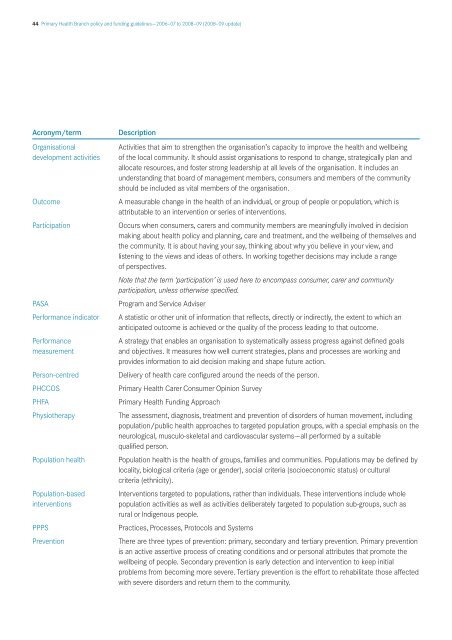Primary Health Branch policy and funding guidelines
Primary Health Branch policy and funding guidelines
Primary Health Branch policy and funding guidelines
Create successful ePaper yourself
Turn your PDF publications into a flip-book with our unique Google optimized e-Paper software.
44 <strong>Primary</strong> <strong>Health</strong> <strong>Branch</strong> <strong>policy</strong> <strong>and</strong> <strong>funding</strong> <strong>guidelines</strong>––2006–07 to 2008–09 (2008–09 update)<br />
Acronym/term<br />
Organisational<br />
development activities<br />
Outcome<br />
Participation<br />
PASA<br />
Performance indicator<br />
Performance<br />
measurement<br />
Person-centred<br />
PHCCOS<br />
PHFA<br />
Physiotherapy<br />
Population health<br />
Population-based<br />
interventions<br />
PPPS<br />
Prevention<br />
Description<br />
Activities that aim to strengthen the organisation’s capacity to improve the health <strong>and</strong> wellbeing<br />
of the local community. It should assist organisations to respond to change, strategically plan <strong>and</strong><br />
allocate resources, <strong>and</strong> foster strong leadership at all levels of the organisation. It includes an<br />
underst<strong>and</strong>ing that board of management members, consumers <strong>and</strong> members of the community<br />
should be included as vital members of the organisation.<br />
A measurable change in the health of an individual, or group of people or population, which is<br />
attributable to an intervention or series of interventions.<br />
Occurs when consumers, carers <strong>and</strong> community members are meaningfully involved in decision<br />
making about health <strong>policy</strong> <strong>and</strong> planning, care <strong>and</strong> treatment, <strong>and</strong> the wellbeing of themselves <strong>and</strong><br />
the community. It is about having your say, thinking about why you believe in your view, <strong>and</strong><br />
listening to the views <strong>and</strong> ideas of others. In working together decisions may include a range<br />
of perspectives.<br />
Note that the term ‘participation’ is used here to encompass consumer, carer <strong>and</strong> community<br />
participation, unless otherwise specified.<br />
Program <strong>and</strong> Service Adviser<br />
A statistic or other unit of information that reflects, directly or indirectly, the extent to which an<br />
anticipated outcome is achieved or the quality of the process leading to that outcome.<br />
A strategy that enables an organisation to systematically assess progress against defined goals<br />
<strong>and</strong> objectives. It measures how well current strategies, plans <strong>and</strong> processes are working <strong>and</strong><br />
provides information to aid decision making <strong>and</strong> shape future action.<br />
Delivery of health care configured around the needs of the person.<br />
<strong>Primary</strong> <strong>Health</strong> Carer Consumer Opinion Survey<br />
<strong>Primary</strong> <strong>Health</strong> Funding Approach<br />
The assessment, diagnosis, treatment <strong>and</strong> prevention of disorders of human movement, including<br />
population/public health approaches to targeted population groups, with a special emphasis on the<br />
neurological, musculo-skeletal <strong>and</strong> cardiovascular systems––all performed by a suitable<br />
qualified person.<br />
Population health is the health of groups, families <strong>and</strong> communities. Populations may be defined by<br />
locality, biological criteria (age or gender), social criteria (socioeconomic status) or cultural<br />
criteria (ethnicity).<br />
Interventions targeted to populations, rather than individuals. These interventions include whole<br />
population activities as well as activities deliberately targeted to population sub-groups, such as<br />
rural or Indigenous people.<br />
Practices, Processes, Protocols <strong>and</strong> Systems<br />
There are three types of prevention: primary, secondary <strong>and</strong> tertiary prevention. <strong>Primary</strong> prevention<br />
is an active assertive process of creating conditions <strong>and</strong> or personal attributes that promote the<br />
wellbeing of people. Secondary prevention is early detection <strong>and</strong> intervention to keep initial<br />
problems from becoming more severe. Tertiary prevention is the effort to rehabilitate those affected<br />
with severe disorders <strong>and</strong> return them to the community.

















